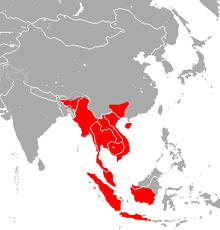Intermediate roundleaf bat
The intermediate roundleaf bat (Hipposideros larvatus) is a species of bat in the family Hipposideridae. It is found in Bangladesh, Cambodia, China, India, Indonesia, Laos, Malaysia, Myanmar, Thailand, and Vietnam.
| Intermediate roundleaf bat | |
|---|---|
| from southern Lampung, Sumatra | |
| Scientific classification | |
| Kingdom: | Animalia |
| Phylum: | Chordata |
| Class: | Mammalia |
| Order: | Chiroptera |
| Family: | Hipposideridae |
| Genus: | Hipposideros |
| Species: | H. larvatus |
| Binomial name | |
| Hipposideros larvatus (Horsfield, 1823) | |
 | |
| Intermediate roundleaf bat range | |
Geographic location
The intermediate leaf-nosed bat is widespread in Asia with a geographical distribution that includes Bangladesh (Chittagong and Sylhet divisions), China, Thailand, Cambodia, Laos, Vietnam, Indonesia (Bali, Kalimantan, Sumatera), Malaysia (Peninsular Malaysia, Sabah, Sarawak), Myanmar, and India (Arunachal Pradesh, Assam, Meghalaya). In Mainland China, the species is found in South and Southwest China, including Yunnan, Guizhou, Guangdong, Guangxi, Hainan.
Habitat
Hipposideros larvatus typically roosts in caves. But they also roost in abandoned mines, rock crevices, mines shafts, pagodas, buildings, and tropical moist forest. It is also found roosting in human habitations. Roosts may contain several hundred bats of both sexes. And H. larvatus often shares their roost with other bat species. This species is primarily found at altitudes from 182 to 860 meters, but in Yunnan this bat was found at 1480 meters.
Morphological description
There are several diagnostic features of the intermediate roundleaf bat and they are: the three lateral accessory leaflets on each side of the noseleaf, dark grey-brown or reddish brown fur color (dorsal fur is a uniform cinnamon brown, while the ventral fur is lighter grey), dark grey or brown ears and noseleaf, broad and triangular shaped ears, and that juveniles are darker than adults. The average forearm length is about 55.5-62.2mm. With an average body mass of 17.4 - 24.8g. Its ear length is around 17–22 mm.
Diet
The major diet for H. larvatus consist mainly of beetles. But it also eats moths, butterflies, flies, mosquitoes, termites, insects from the Hemiptera order, caddisfly, sawfly, ants, wasps, spiders, mites, and ticks.
Echolocation calls
This particular species of bats emit an average resting frequency (RF) of 85 kHz.
External links
References
- Bates, P.; Bumrungsri, S.; Suyanto, A.; Molur, S. & Srinivasulu, C. (2008). "Hipposideros larvatus". IUCN Red List of Threatened Species. 2008: e.T10143A3173793. doi:10.2305/IUCN.UK.2008.RLTS.T10143A3173793.en.
- Chiroptera Specialist Group 1996. Hipposideros larvatus. 2006 IUCN Red List of Threatened Species. Downloaded on 30 July 2007.
- Thabah, Adora et al. Genetic divergence and echolocation call frequency in cryptic species of Hipposideros larvatus s.l. (Chiroptera: Hipposideridae) from the Indo-Malayan region.Biological Journal of the Linnean Society. May2006, Vol. 88 Issue 1, p119-130.
- Hipposideros larvatus Intermediate Roundleaf Bat; Horsfield's Leaf-nosed Bat
- Ecology Asia Intermediate Roundleaf Bat
